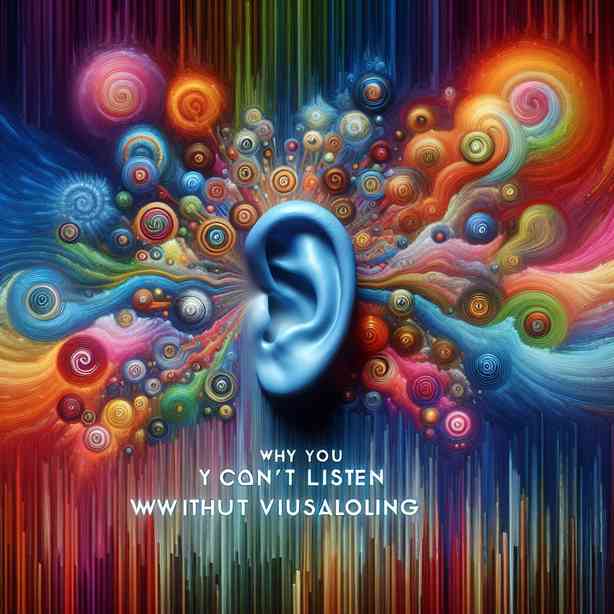
In the intricate tapestry of human perception, listening and visualization are interwoven in ways that profoundly dictate our understanding of the world around us. The relationship between these two senses is often overlooked, even though they play crucial roles in how we interpret information, communicate with others, and navigate our daily lives. To understand why experiencing auditory information often necessitates a form of visualization, we must delve into several cognitive and psychological dimensions.
Listening is not merely a passive activity; it is an active process that engages our brains in complex ways. When we hear sounds, our brains are tasked with interpreting these auditory signals. This process involves recognizing patterns, discerning language, and making sense of the emotional undertones conveyed through tone and intonation. However, for many, the experience doesn’t end there. In attempting to understand or remember what we’ve heard, our minds often conjure up images—whether abstract or concrete—that help contextualize the auditory information. This visualization process enhances our comprehension and retention of the material.
Research in cognitive science supports this intersection. Studies have shown that when individuals listen to spoken language, they frequently engage in imagery generation, which taps into the brain’s visual processing areas. This phenomenon is evident in various scenarios: while listening to a story, one may visualize the characters and settings, or when instructed on how to perform a task, the mind might map out the steps visually. This illustrates the concept that our cognitive processes are highly multimodal; different sensory modalities work together to create a coherent understanding of our experiences.
Moreover, this relationship between listening and visualization has profound implications in educational contexts. Effective teaching techniques often incorporate visual aids alongside auditory instructions. When learners are presented with diagrams, charts, or videos along with verbal explanations, they can integrate the information more efficiently. The visual component serves not only to engage the audience but also to reinforce what is being conveyed, thereby leading to a deeper understanding and improved retention. This practice highlights a key strategy in education: by appealing to multiple senses, we can enhance learning experiences.
However, the importance of this relationship extends beyond academic settings. In professional environments, effective communication is vital for collaboration and teamwork. When team members present ideas, discussions often benefit from visual support, such as slides or demonstrations, which can aid in conveying complex concepts. The act of visualizing information during such exchanges allows individuals to question, analyze, and synthesize information more effectively. Thus, effective communicators may harness this interplay to promote clearer and more impactful dialogues.
In the realm of personal relationships, listening is equally essential, and visualization often plays a role in fostering empathy and connection. When someone shares a personal experience, the listener’s ability to visualize the scenario helps bridge the gap between the speaker’s feelings and the listener’s understanding. This empathetic engagement enables the listener to relate to the speaker’s experience more profoundly, creating a sense of connection and intimacy that strengthens interpersonal bonds.
However, the necessity to visualize while listening can also present challenges. For individuals with certain cognitive or sensory processing differences, this interaction may lead to information overload. When the brain attempts to process extensive auditory information alongside simultaneous visual imagery, it can become overwhelming. This complexity emphasizes the need for mindfulness in communication, where we consider not only our own methods of processing information but also the perspectives and capabilities of others.
Understanding the dynamic between listening and visualization opens up avenues for improvement in our communication strategies. Practicing active listening—where one focuses entirely on the speaker without distractions—can enhance the relationship between auditory and visual processing. Taking the time to pause, reflect, and mentally visualize what is being said can improve comprehension and lead to more meaningful interactions. This approach not only benefits the listener but also validates the speaker’s message, fostering a more inclusive and productive communication environment.
As we navigate our increasingly interconnected world, the importance of this relationship cannot be overstated. With the influx of information through various media, the ability to effectively listen and visualize has become a vital skill. In the digital age, where visual content often accompanies auditory messages, honing this ability will be crucial for success in both personal and professional realms. Being able to synthesize and interpret information through multiple channels will enable individuals to become more adept at navigating complex situations and fostering collaborative environments.
In conclusion, the intricate bond between listening and visualization is a testament to the complexity of human cognition. As we engage with the world through sound and sight, we should recognize and embrace the power of these senses working in tandem. Whether it’s in education, professional settings, or personal relationships, understanding and mobilizing this relationship can lead to enhanced communication and deeper connections. By developing our ability to listen actively and visualize information accurately, we can empower ourselves and those around us, fostering a richer tapestry of understanding in our shared human experience.


